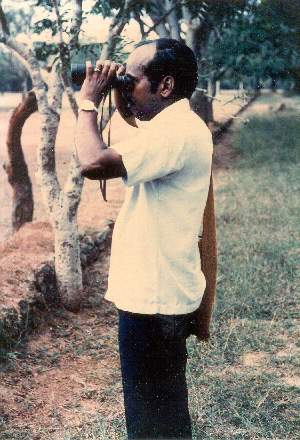
Home | Biodata | Biography | Photo Gallery | Publications | Tributes
Nature Study

 |
Home | Biodata | Biography | Photo Gallery | Publications | Tributes Nature Study |
 |
The latest addition to the check-list of Tambaram birds (Scientific Report No. 2, Dept. of Statistics, February 1971) is the Nun (Lonchura malacca) which is also known as the Black-headed Munia or the Chestnut Mannikin. It is a handsome little bird, smaller than the House Sparrow, has a black head, chestnut (same colour as the female Paradise Flycatcher) wings and white lower plumage with some black. It is fancied as a cage-bird. The bird was observed for the first time in Tambaram in June 1975 and it is the hundred and fifty-first entry in our list of Tambaram birds
The Black-headed Munia (Nun) is one of the five Munias that have been recorded on Campus. Jerdon's Rufous-breasted Munia is a rare winter visitor and has been observed only once. During the hot season (June 15, 1975), I found a large number of Munias and Weaver Birds roosting in the Scrub jungle area on the eastern side of the campus near the farm. One evening I counted more than a thousand birds--Weaver birds and Munias--roosting in the area. The birds came from all the four directions. There were the common White-throated Munias(Common Selverbill), the not so common White-backed Munias(Striated Mannikin) and the Spotted Munia(Nutmeg Mannikin).
The Black-headed Munia or the Nun (about Nat.size)
|
|  |
  |  Southeastern Tree Pie (much reduced). |
We are familiar with the intricate nests of the Baya (Weaver Bird). The Munias build a different kind of nest--large ball-shaped nest with the entrance at the side. Even after the young have learnt to fly, the whole family returns to the nest to roost, a practice peculiar to the Munias.
The Munias, the Sparrows and the Weaver Birds (Bayas) belong to one family called Ploceidae. Besides the House Sparrow (Passer domesticus) which is found near human habitations all over the world, we also have the Yellow-throated Sparrow which might be mistaken for a House Sparrow by a casual observer. Birds that belong to this family are primarily seed-eaters and many of them eat ripening paddy and other grains. In an experimental plot in the college Farm, it was found that the white name-boards kept the birds away from paddy. The birds also eat seeds of grass and it is believed that they might control the spread of weeds. Birds such as the Baya feed on insects thereby controlling insects population There appear to be more seed-eating birds on campus now compared to ten years ago when there was not so much paddy cultivation. The farm may attract more varieties of grain eating birds of the locality in years to come.
II. THE TREE PIE:
On the morning of January 23, my attention was drawn to the presence of an unusual bird visitor to our garden (sure the bird knew where it would be noticed! -Ed). A large bird of the size of a Koel was perched on top of the Neem tree and calling out in a melodious voice. It was an orangish brown bird with a grey head and a long tail.
The bird is called maanguil in Tamil and 'Southeastern Tree Pie' in English. It belongs to the Crow family (Corvidae) and is known as Dendrocitta vagabunda. It is not an uncommon bird in Tamilnadu, but this is the first time it is recorded in Tambaram.
The bird is known to feed on a variety of fruits, insects, reptiles, small rodents and bats. It also eats eggs and nestlings of birds and is known to destroy the nests of weaver birds and eat their eggs and the young ones. We should watch with interest the new addition (see 152 of the 'Checklist' ) to our bird population.
[Munias are known to build their nests inside the abandoned nests of Bayas. Last September, a nest of the weaver bird hung on a creeper for decoration was occupied by a pair of White-backed Munias and four white eggs were noticed. However, the eggs disappeared later, perhaps being taken away by predators. The Munias built a shallow nest with thin grass inflorescences within the Baya's nest.-- Ed.]
[" The greatest need now is to turn from the museum and the laboratory to the field--in other words to pursue the study of the living bird in its natural habitat and collect precise information about its ecology, habits and behaviour ..." -- Salim Ali & Laeeq Futehally in 'Common Birds', NBT, 1967.]